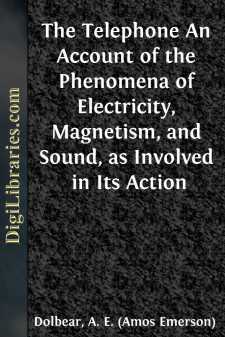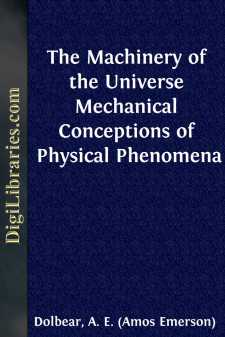Categories
- Antiques & Collectibles 13
- Architecture 36
- Art 48
- Bibles 22
- Biography & Autobiography 813
- Body, Mind & Spirit 142
- Business & Economics 28
- Children's Books 14
- Children's Fiction 11
- Computers 4
- Cooking 94
- Crafts & Hobbies 4
- Drama 346
- Education 46
- Family & Relationships 57
- Fiction 11829
- Games 19
- Gardening 17
- Health & Fitness 34
- History 1377
- House & Home 1
- Humor 147
- Juvenile Fiction 1873
- Juvenile Nonfiction 202
- Language Arts & Disciplines 88
- Law 16
- Literary Collections 686
- Literary Criticism 179
- Mathematics 13
- Medical 41
- Music 40
- Nature 179
- Non-Classifiable 1768
- Performing Arts 7
- Periodicals 1453
- Philosophy 64
- Photography 2
- Poetry 896
- Political Science 203
- Psychology 42
- Reference 154
- Religion 513
- Science 126
- Self-Help 84
- Social Science 81
- Sports & Recreation 34
- Study Aids 3
- Technology & Engineering 59
- Transportation 23
- Travel 463
- True Crime 29
The Telephone An Account of the Phenomena of Electricity, Magnetism, and Sound, as Involved in Its Action
Description:
Excerpt
ELECTRICITY.
Some of the phenomena of electricity are manifested upon so large a scale as to be thrust upon the attention of everybody. Thus lightning, which accompanies so many showers in warm weather in almost every latitude, has always excited in some individuals a superstitious awe, as being an exhibition of supernatural agency; and probably every one feels more or less dread of it during a thunder-shower, and this for the reason that it affects so many of the senses at the same time. The flash may be blinding to the eyes if near to us; the thunder may be deafening to the ears, and so powerful as to shake the foundations of the hills, and make the ground upon which we stand to sensibly move: these with the remembered destructive effects that have been witnessed, of buildings demolished and large trees torn to splinters in an instant, are quite sufficient to raise a feeling of dread in the strongest mind. In the polar regions, both north and south, where thunder-storms are less frequent, the atmospheric electricity assumes the form called the aurora borealis, or the aurora australis, according as it is seen north or south of the equator.
More than two thousand years ago it was noticed by the Greeks that a certain kind of a mineral which was thrown up on the shores of the Mediterranean Sea, when rubbed would attract light bodies, such as shreds of silk or linen and bits of paper. To this substance they gave the name of Elektron, and the property developed thus by friction was afterwards called electricity. In 1600 Dr. Gilbert, physician to Queen Elizabeth, published a book in which he described numerous experiments demonstrating that electricity could be developed by friction upon a great variety of substances, such as stones, gems, and resins. The first machine for developing electricity was made by Otto von Guericke of Magdeburg, about 1680. His machine consisted of a ball of sulphur about six inches in diameter, which could be rotated. If the dry hand were held against the sulphur while it was being turned in a dark room, the sphere appeared to emit light: it also gave out a peculiar hissing or crackling sound. Newton experimented a little with electricity, and noticed that the rubber was an important element in developing electricity. He does not seem to have given to the subject the same attention that he gave to some other departments of science. Had he done so, it is probable that he would have advanced the study a hundred years; that is to say, he would probably have left it at the place where it actually was in 1790. So great were his abilities that in one lifetime he made greater additions to human knowledge than all the rest of mankind had made during the preceding thousand years. In the month of June, 1752, Franklin made that memorable experiment which immortalized him. He flew his kite to the thunder-cloud, practically asking the question of the lightning whether or not it was identical with electricity. The lightning came down the wetted twine to his hand, and proclaimed its identity.
For the next forty years the natural philosophers in both Europe and America only rung the changes upon what was known....



